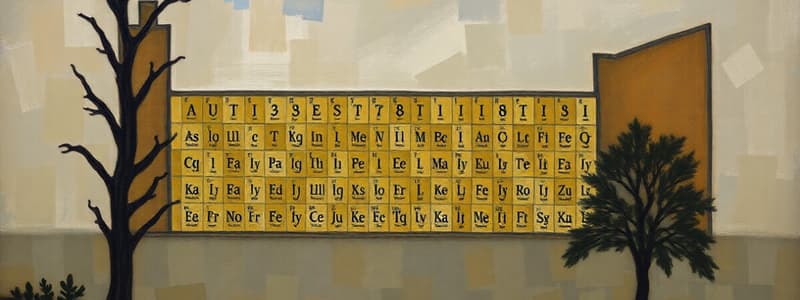Podcast
Questions and Answers
Describe the trend in ionization energy down group 2.
Describe the trend in ionization energy down group 2.
Ionization energy decreases down group 2 due to added electron shells, increased shielding, and greater distance between outer electrons and the nucleus.
Describe and explain the trend of atomic radius as you go down group 2.
Describe and explain the trend of atomic radius as you go down group 2.
Atomic radius increases down group 2 because extra electron shells are added.
What ions do group 2 elements form when they react?
What ions do group 2 elements form when they react?
+2
Group 2 elements react with water to produce what? Give the general equation and the ions in the product.
Group 2 elements react with water to produce what? Give the general equation and the ions in the product.
Group 2 elements burn in oxygen to form what? Give the general equation and the ions in the product.
Group 2 elements burn in oxygen to form what? Give the general equation and the ions in the product.
Group 2 elements react with chlorine to form what? Give the general equation and the ions in the product.
Group 2 elements react with chlorine to form what? Give the general equation and the ions in the product.
Magnesium reacts with steam to form what? Give the equation.
Magnesium reacts with steam to form what? Give the equation.
Explain the trend in reactivity of Group 2 down the group.
Explain the trend in reactivity of Group 2 down the group.
Which group 2 oxide is insoluble?
Which group 2 oxide is insoluble?
Group 2 oxides react with H₂O to form what? Give the general equation.
Group 2 oxides react with H₂O to form what? Give the general equation.
Group 2 metals react with dilute hydrochloric acid to form what? Give the general equation.
Group 2 metals react with dilute hydrochloric acid to form what? Give the general equation.
Group 2 metals react with dilute sulfuric acid to form what? Give the general equation.
Group 2 metals react with dilute sulfuric acid to form what? Give the general equation.
Group 2 oxides react with dilute hydrochloric acid to form what? give the general equation
Group 2 oxides react with dilute hydrochloric acid to form what? give the general equation
Group 2 oxides react with dilute sulfuric acid to form what? give the general equation
Group 2 oxides react with dilute sulfuric acid to form what? give the general equation
What type of reaction occurs between group 2 hydroxides and dilute acid?
What type of reaction occurs between group 2 hydroxides and dilute acid?
Hydroxides react with dilute hydrochloric acid to form what? Give the general equation.
Hydroxides react with dilute hydrochloric acid to form what? Give the general equation.
Hydroxides react with dilute sulfuric acid to form what? Give the general equation.
Hydroxides react with dilute sulfuric acid to form what? Give the general equation.
Describe the solubility trend of the hydroxides down group 2.
Describe the solubility trend of the hydroxides down group 2.
How can magnesium hydroxide be used in medicine?
How can magnesium hydroxide be used in medicine?
Describe the solubility trend of the group 2 sulphates.
Describe the solubility trend of the group 2 sulphates.
Which group 2 sulphate is insoluble?
Which group 2 sulphate is insoluble?
What can barium sulfate be used for due to it's insoluble nature and why?
What can barium sulfate be used for due to it's insoluble nature and why?
What is the test for sulfate ions? Give the equation
What is the test for sulfate ions? Give the equation
Define thermal stability.
Define thermal stability.
Explain why thermal stability increases down group 2.
Explain why thermal stability increases down group 2.
Why are group 2 compounds less thermally stable than group1.
Why are group 2 compounds less thermally stable than group1.
Group 1 carbonates decompose to form what?
Group 1 carbonates decompose to form what?
Group 1 nitrates decompose to form what?
Group 1 nitrates decompose to form what?
What does the observation of brown fumes mean when heating group 1 and 2 nitrates?
What does the observation of brown fumes mean when heating group 1 and 2 nitrates?
What is the overall pattern for decomposition in the group 1 and 2 nitrated and carbonates? Explain why...
What is the overall pattern for decomposition in the group 1 and 2 nitrated and carbonates? Explain why...
How would you measure the thermal stability of nitrates?
How would you measure the thermal stability of nitrates?
How would you test the thermal stability of carbonates?
How would you test the thermal stability of carbonates?
What is the flame colour of Lithium?
What is the flame colour of Lithium?
What is the flame colour for potassium?
What is the flame colour for potassium?
What is the flame colour for rubidium?
What is the flame colour for rubidium?
What is the flame colour for beryllium?
What is the flame colour for beryllium?
What is the flame colour for mangnesium?
What is the flame colour for mangnesium?
What is the flame colour of Strontium?
What is the flame colour of Strontium?
How would you carry out the flame test?
How would you carry out the flame test?
Why do we see colours in the flame test?
Why do we see colours in the flame test?
What are the 2 main problems with flame tests?
What are the 2 main problems with flame tests?
What is the test for ammonium ions? Give the equation
What is the test for ammonium ions? Give the equation
Flashcards
Ionisation Energy Trend in Group 2
Ionisation Energy Trend in Group 2
Ionisation energy decreases down group 2 due to added electron shells and shielding.
Atomic Radius Trend in Group 2
Atomic Radius Trend in Group 2
The atomic radius increases down group 2 due to the addition of extra electron shells.
Group 2 Ions Formation
Group 2 Ions Formation
Group 2 elements form +2 ions when they react.
Group 2 Reaction with Water
Group 2 Reaction with Water
Signup and view all the flashcards
Group 2 Reaction with Oxygen
Group 2 Reaction with Oxygen
Signup and view all the flashcards
Group 2 Reaction with Chlorine
Group 2 Reaction with Chlorine
Signup and view all the flashcards
Magnesium and Steam Reaction
Magnesium and Steam Reaction
Signup and view all the flashcards
Reactivity Trend in Group 2
Reactivity Trend in Group 2
Signup and view all the flashcards
Insoluble Group 2 Oxide
Insoluble Group 2 Oxide
Signup and view all the flashcards
Group 2 Hydroxides in Water
Group 2 Hydroxides in Water
Signup and view all the flashcards
Reaction with Hydrochloric Acid
Reaction with Hydrochloric Acid
Signup and view all the flashcards
Sulfate Formation
Sulfate Formation
Signup and view all the flashcards
Reaction with Nitric Acid
Reaction with Nitric Acid
Signup and view all the flashcards
Hydroxides with Hydrochloric Acid
Hydroxides with Hydrochloric Acid
Signup and view all the flashcards
Solubility Trend of Hydroxides
Solubility Trend of Hydroxides
Signup and view all the flashcards
Barium Sulfate Insolubility
Barium Sulfate Insolubility
Signup and view all the flashcards
Test for Sulfate Ions
Test for Sulfate Ions
Signup and view all the flashcards
Thermal Stability Definition
Thermal Stability Definition
Signup and view all the flashcards
Thermal Stability Trend in Group 2
Thermal Stability Trend in Group 2
Signup and view all the flashcards
Flame Test of Lithium
Flame Test of Lithium
Signup and view all the flashcards
Flame Color for Sodium
Flame Color for Sodium
Signup and view all the flashcards
Chlorine in Water Color
Chlorine in Water Color
Signup and view all the flashcards
Reaction Type of Group 2 Hydroxides and Acids
Reaction Type of Group 2 Hydroxides and Acids
Signup and view all the flashcards
Reducing Power of Halide Ions Trend
Reducing Power of Halide Ions Trend
Signup and view all the flashcards
Displacement Rule for Halogens
Displacement Rule for Halogens
Signup and view all the flashcards
Study Notes
Group 2 Elements
- Group 2 elements form +2 ions when reacting.
- Reactivity increases down the group.
- Ionisation energy decreases down the group due to increased shielding and distance from the nucleus.
- Atom radius increases down the group due to added electron shells.
- Group 2 oxides are generally basic oxides. Beryllium oxide is insoluble.
- Group 2 hydroxides are soluble to different degrees, increasing down the group. Magnesium hydroxide can be used as an antacid.
- Group 2 sulphates are soluble to different extents, decreasing down the group. Barium sulphate is insoluble. Barium sulphate is used in medical imaging due to insolubility.
- Thermal stability increases down the group.
- Group 2 carbonates and nitrates decompose when heated to form metal oxides, carbon dioxide, and nitrogen dioxide. Lithium compounds show exceptions.
- Flame tests can be used to identify Group 2 metals.
Group 2 Reactions
- Group 2 metals react with water to produce hydroxides and hydrogen gas.
- Group 2 metals react with oxygen to produce oxides.
- Group 2 metals react with chlorine to produce chlorides.
- Group 2 metals react with steam to form oxides and hydrogen gas.
- Group 2 oxides react with water to form hydroxides.
- Group 2 metals react with dilute acids (hydrochloric, sulfuric, nitric) to produce metal salts and hydrogen gas.
- Group 2 hydroxides react with dilute acids to produce metal salts and water.
- Reactions with dilute acids are neutralisation reactions.
Group 7 Elements
- The halogens exist as diatomic molecules in different states at room temperature.
- Reactivity decreases down the group.
- Atomic radius increases down the group.
- Melting and boiling points increase down the group.
- Electronegativity decreases down the group.
- Oxidising power decreases down the group, reducing power increases down the group.
- Displacement reaction between halogens: more reactive halogen displaces a less reactive halogen from its compound.
- Halogens can be tested by seeing how they affect organic solvents; colour and states during displacement reactions (organic solvent).
- Chlorine, bromine, and iodine have different colours in water and organic solvents (hexane).
- Halogens are oxidising agents. Halide ions are reducing agents.
- Halogens react with group 1 and 2 metals to form halide salts.
- Halogens can undergo disproportionation reactions (simultaneous oxidation and reduction).
- Chlorine reacts with water and cold dilute alkali to form chlorate(I) compounds (bleach).
- Chlorine reacts with hot concentrated alkali to form chlorate(V) compounds.
- Halide ions can be distinguished with silver nitrate test.
- Reaction with acids can be a redox reaction
Tests and Observations
- Flame tests identify metals by colour.
- Test for ammonium ions involve adding sodium hydroxide solution, warming, and observing the release of ammonia gas.
- Test for sulfate ions involves acidified barium chloride, looking for a white precipitate of barium sulphate.
- Halogen displacement tests involve using organic solvents and observing colour changes(e.g. in hexane) and the formations of precipitates.
- Tests for halide ions involve adding silver nitrate solution to produce silver halide precipitates.
- The colour, solubility in ammonia, and other aspects of the reaction are important observations.
- Reaction of hydrogen halides with water produce dilute acids.
Studying That Suits You
Use AI to generate personalized quizzes and flashcards to suit your learning preferences.




